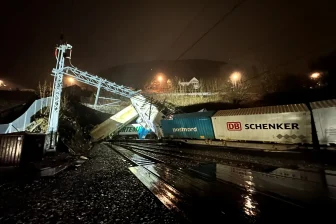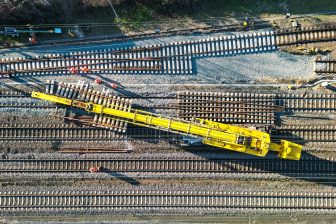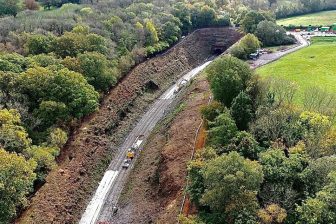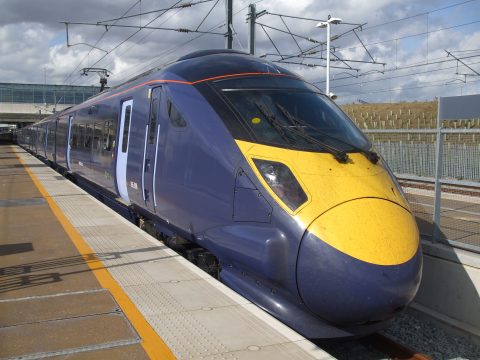
Report details vision for British railway network by 2040
According to a new report, Great-Britain needs to develop a national rail strategy with a specific objective. It is crucial to do so as the UK leaves the EU, in order to drive productivity in the country and stimulate the economy, the report concludes. The report sets out to develop a vision of what the British railway network should look like by 2040.
The report is a follow-up on plans of the government to build a second high-speed line in the United Kingdom. High Speed 2 (HS2) is a plan for a high-speed railway in the United Kingdom. It is going to run between London, Birmingham, the East Midlands, Leeds and Manchester. It is the second British high-speed railway and will become operational in phases from 2026 to 2033.
The new report ‘Beyond the HS2’ by non-profit organisation Greengauge 21 sets out to develop a vision of what the British railway network should look like by 2040, in order to serve both the nation and the public in the most efficient and effective way. It argues that Britain has never had a single vision for its railway network, beyond one or two mega-projects. The railway network plays a vital role in supporting the national economy. The country can not become too reliant on the road network or on the new HS2, the report argues. The report is based on almost a year of analysis and research.
High Speed 2
The main conclusion of the ‘Beyond the HS2’ report is that the HS2 should be differently shaped, in order to best serve the country. Currently, the network is planned to be shaped like a ‘Y’. The report argues that the railways lines should be shaped like an ‘X’ instead, with a new connection in the West Midlands. This means that HS2 trains could operate from Bristol and Cardiff to destinations in the Midlands, the North and Scotland.
Other key proposal in the report include fully integrating HS2 into the national network, a major upgrade of the East Coast mainline and new high speed lines in Scotland and Essex & East Anglia.
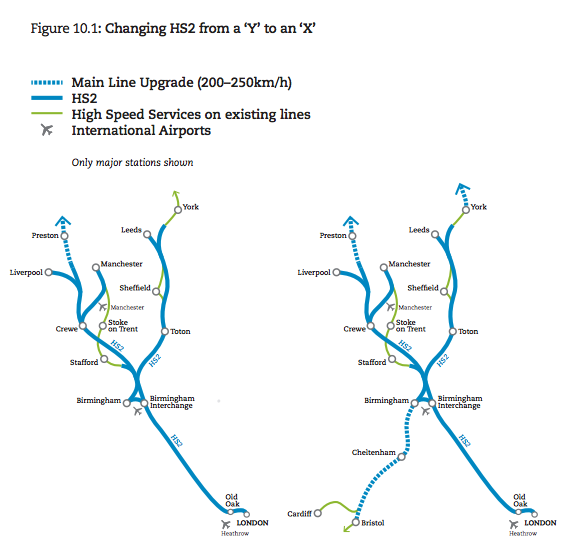
The left image shows the HS2 as it is currently planned. The image on the right shows Greengauge 21’s vision of HS2. Source: Beyond the HS2.
Left behind
Part of the report’s conclusion covers inclusivity and the need for social mobility in order to foster economic growth in all parts of the country. The report mentions places ‘left behind’: places in Britain that are struggling economically. The report argues that it is necessary to further develop the rail network in these areas and ‘re-connect’ them to the rest of the country, because job loss due to automation is most likely in these locations. Inhabitants of the areas need to be able to take public transportation to other jobs, if and when jobs disappear in these industrial areas.
To re-connect these places ‘left behind’, new rail connections are needed including to towns in the East & West Midlands, North East England and Yorkshire. Beyond trains, the report asserts that the rail network needs to be connected to interurban buses. EU funding has been used to develop transport in these parts of Britain. As the country leaves the EU, the report argues that it is ‘essential’ to replace these funds: “places already written-off cannot be expected to survive unscathed otherwise.”
Long term strategy
One of the report’s five co-authors, Greengauge 21 Director Jim Steer, said: “Britain lacks a long term national railway strategy beyond HS2. We need a plan to put rocket fuel into our economic productivity and this report sets out proposals to do so.”
“It is vital for the future of the country that no region is left behind and the national railway strategy needs to reach all parts of the country. To transform productivity across the whole of Britain, we need to transform the connectivity of dozens of cities. Fundamentally, we need to completely re-orientate the railway from a ‘hub-and-spoke’ centred on London, to a fully national network.”

